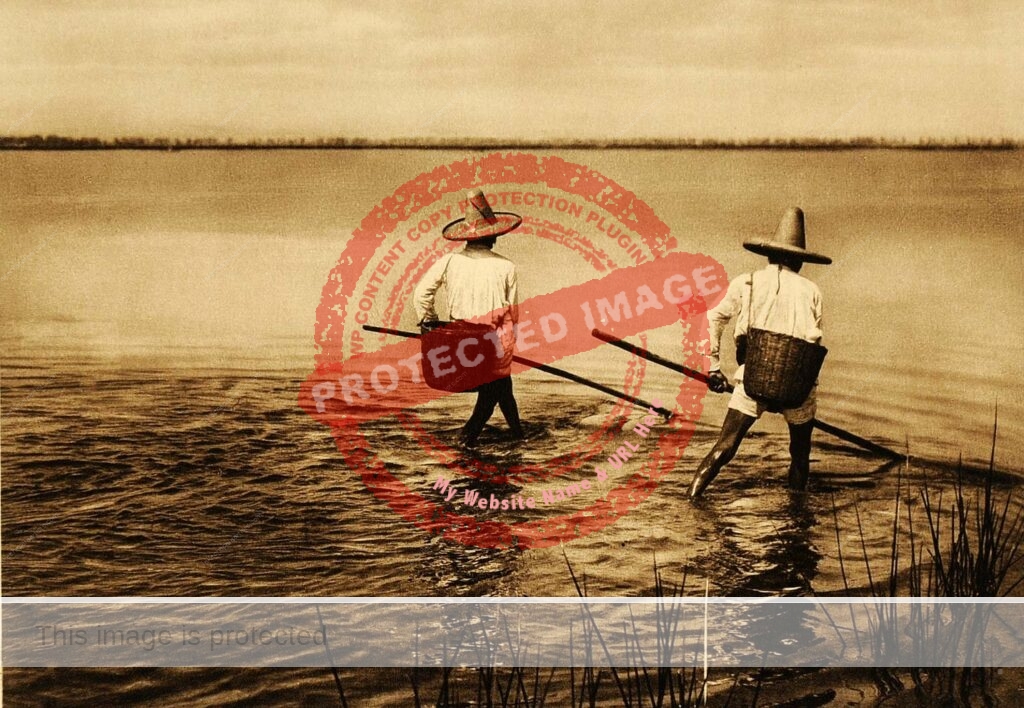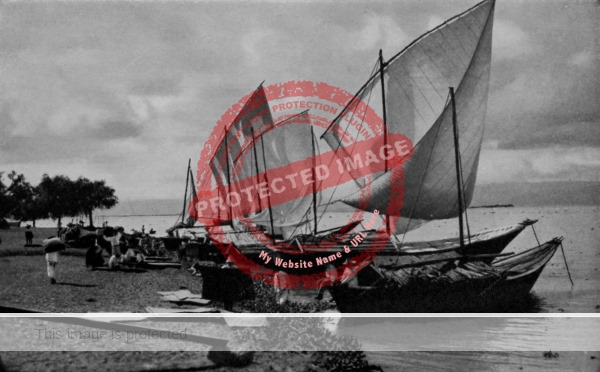Hugo Brehme was born in Eisenach, Germany, 3 December 1882, and died on 13 June 1954 as a result of an auto accident in Mexico City. Brehme certainly visited and photographed Lake Chapala on more than one occasion. Images of the lake and its environs appear in his work from around 1920.

Often cited as Hugo Brehme, Fishermen in Lake Chapala, c 1925, this photo dates from 1907 and was the work of Sumner W Matteson (see comments)
Brehme studied photography in Erfurt, completing his studies in 1902, and then opened his own studio. He took several trips to the then-German colonies in Africa.
He first visited Mexico in 1906, strongly influenced by having read Mexiko: Eine Reise Durch das Land der Azteken (“Mexico, a journey through the land of the Aztecs“) by Oswald Schroeder (published in Leipzig 1905).
On 14 August 1906, Brehme, then 23 years old, left Hamburg for Veracruz, Mexico, on board the SS Fürst Bismarck, traveling 3rd class. The ship called in at Dover (U.K.), Le Havre (France), Santander (Spain), A Coruña (Portugal) and Cuba, en route to Mexico.
He clearly liked what he found in Mexico, and saw a future there, since he returned to Germany, married his sweetheart Auguste Hartmann, and soon afterwards, in August 1908, the couple were on their way back there. They traveled on the SS Kronprinzessin Cecilie, but this time in the relative luxury of 2nd class!
By 1910, Brehme had a studio in Mexico City and rapidly gained popularity among the wealthier residents. The following year, he joined Casasola’s Agencia Fotográfica Mexicana. He documented many of the key events of the Mexican Revolution (1910-20), including the Decena Trágica of 1913, Emiliano Zapata’s activities in Morelos, and the 1914 U.S. intervention in Veracruz.
Brehme quickly established himself as an outstanding commercial photographer, specializing in black-and-white postcard views. For more than 40 years, he roamed the country, using excellent photographic technique and composition to capture all manner of scenes. Some of his images are hauntingly beautiful, reminding us of a bygone age that we can never hope to regain.
The 1927 edition of Terry’s Guide to Mexico recommends Brehme as having “the largest, most complete and most beautiful collection of artistic photographs (views, types, churches, etc.) in Mexico.”
Brehme’s best-known photographic book is México pintoresco (“Picturesque Mexico”) which was published in 1923. A second volume Picturesque Mexico: The Country, The People and The Architecture appeared in 1925 (in English, French and German). These are among the masterpieces in the history of photography in Mexico.

Hugo Brehme. Boats at Lake Chapala. ca 1925?. (From Marian Storm’s Prologue To Mexico)
Brehme, who is also credited with having introduced the first photographic Christmas cards into Mexico, was granted Mexican citizenship shortly before his death. His son Arno, born in Mexico in 1914, also became a photographer and worked in his father’s studio. Of the relatively small number of photos attributed to Arno (Armando Brehme), perhaps the most interesting are those of the eruption of Paricutin Volcano in 1943.
There is no question that some images signed by Brehme were actually taken by other photographers, and there are doubts about others. For example, see this analysis (in Spanish) of some of his photos. Equally, there is no doubt that many Brehme photos were used, without adequate attribution, by other authors.
These issues aside, Brehme was clearly a master of publicity, and helped to foment an interest in Mexico, and travel in Mexico, that extended far beyond its borders.
My 2022 book Lake Chapala: A Postcard History uses reproductions of more than 150 vintage postcards to tell the incredible story of how Lake Chapala became an international tourist and retirement center.
Sources:
- Benigno Casas. “Hugo Brehme: el paisaje romántico y su visión sobre lo mexicano”, Dimensión Antropológica, vol. 41, septiembre-diciembre, 2007, pp. 173-201.
- Arturo Guevara Escobar. Hugo Brehme y la pérdida de la Fe.
- Susan Toomey Frost. Postcards of Hugo Brehme (Spanish). Frost is the author of Timeless Mexico: The Photographs of Hugo Brehme, (University of Texas Press, 2011)
Comments, corrections or additional material welcome, whether via email or comments feature.
Tony Burton’s books include “Lake Chapala: A Postcard History” (2022), “Foreign Footprints in Ajijic” (2022), “If Walls Could Talk: Chapala’s historic buildings and their former occupants” (2020), (available in translation as “Si Las Paredes Hablaran”), “Mexican Kaleidoscope” (2016), and “Lake Chapala Through the Ages” (2008).
Thanks–I was not aware of this fellow and will try to find the book from the Univ. of Texas Press–bill
The top photograph used by Brehme is from the negative made by Sumner W. Matteson in 1907. It is properly identified by printed material of the time. Brehme credits himself tor hundreds of Matteson’s Mexico photographs. Plagiarized? Indeed.
Thanks for this interesting and informative comment. Can you point us towards examples of the printed material you are referring to, please? TB